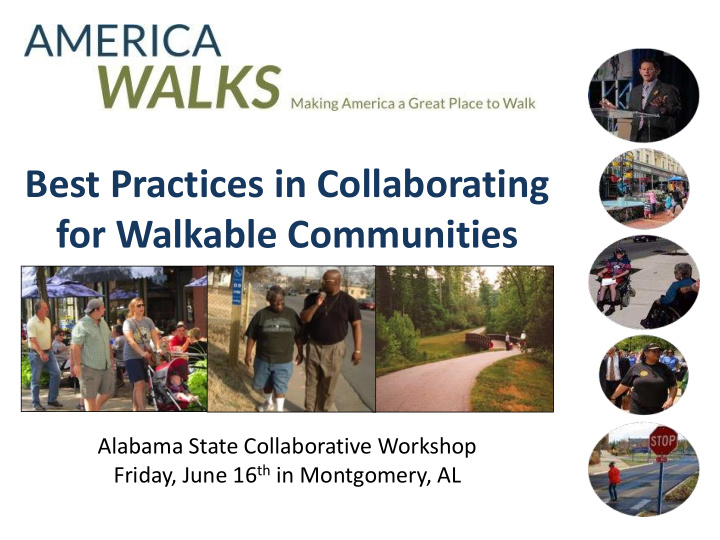



Best Practices in Collaborating for Walkable Communities Alabama State Collaborative Workshop Friday, June 16 th in Montgomery, AL
Local Planning Team
Workshop Goals 1. Strengthen collaboration between ALDOT, ADPH, ADECA, and other partners 1. Develop a shared understanding of the benefits of walkable communities, especially for disadvantaged populations and people with disabilities 1. Learn about the funding process and hear from local mayors about their walkability initiatives 1. Provide feedback on the draft State Bicycle and Pedestrian Plan 1. Commit to a collaborative action plan, moving forward
Workshop Agenda 9:00 am: Welcome and introductions 9:30 am: Presentation: Best Practices in Collaborating for Walkable Communities 10:00 am: Panel discussion with ALDOT, ADPH, and ADECA senior administrators 10:30 am: Break 10:45 am: Small discussion groups: Asset-Mapping Exercise 12:00 pm: Lunch (courtesy of AARP) 12:15 pm: Lunch session: Alabama Local Leaders Panel 1:00 pm: Walkability audits 2:00 pm: ALDOT presentation: Draft State Bicycle and Pedestrian Plan 2:15 pm: Small discussion groups: Strategic Planning Activity 3:30 pm: Commitments for next steps 4:00 pm: Close
Problem #1: Sedentary Lifestyles
Problem #1: Sedentary Lifestyles Adult Obesity
Problem #2: Generational Car Culture In 1969, 50% of American children walked to school In 2006, just 15% walked to school
Problem #2: Generational Car Culture In 1969, 50% of American children walked to school In 2006, just 15% walked to school
Problem #3: Health Care Costs
Problem #3: Health Care Costs $3 trillion
Problem #4: Unsafe Streets
Problem #4: Unsafe Streets Pedestrian fatality risk at different collision speeds
Surgeon General’s Call to Action on Walking and Walkable Communities 8 th September, 2015 Goal 1. Make Walking a National Priority Goal 2. Design Communities that Make It Safe and Easy to Walk for People of All Ages and Abilities Goal 3. Promote Programs and Policies to Support Walking Where People Live, Learn, Work, and Play Goal 4. Provide Information to Encourage Walking and Improve Walkability Goal 5. Fill Surveillance, Research, and Evaluation Gaps Related to Walking and Walkability
Surgeon General’s Call to Action on Walking and Walkable Communities 8 th September, 2015 Goal 1. Make Walking a National Priority Goal 2. Design Communities that Make It Safe and Easy to Walk for People of All Ages and Abilities Goal 3. Promote Programs and Policies to Support Walking Where People Live, Learn, Work, and Play Goal 4. Provide Information to Encourage Walking and Improve Walkability Goal 5. Fill Surveillance, Research, and Evaluation Gaps Related to Walking and Walkability
National Health Care Expenditures
Behavior and Environment “It is unreasonable to expect people to change their behavior … when so many forces in the environment conspire against such change” Institute of Medicine
A Problem for Public Health “How can we change the built environment … so the healthy choice is the easy choice ?”
How are Health and Transportation Collaborating in Other States? Oregon : Memorandum of Understanding Massachusetts : Healthy Transportation Compact and Healthy Transportation Policy Directive North Carolina : Statewide Bicycle and Pedestrian Plan Arkansas : Communities Leading the Way Kentucky : Pedestrian Planning Assistance to Communities Montana: Framework of Aligning Principles Minnesota : Interagency Agreement and Statewide Pedestrian Plan
Montana: Collaborative Framework Of Aligning Principles 1. Safety 2. Mobility and Access 3. Economic Vitality 4. Quality of Life 5. Health and Environment 6. Equity Partners: Montana Dept. of Public Health and Human Services Montana Department of Transportation Montana Department of Commerce Bike Walk Montana
Minnesota: Interagency Agreement
Panel Discussion • Don Arkle, Chief Engineer (representing John Cooper, Director), Alabama Department of Transportation • Dr. Thomas Miller, State Health Officer, Alabama Department of Public Health • Kenneth Boswell, Director, Alabama Department of Economic and Community Affairs
Small Discussion Groups: Asset-Mapping Exercise 1. Why is walkability important to my organization? 1. What desired outcomes or organizational goals do we have in this area? 1. What assets, strengths, and expertise does my organization bring to a partnership focused on walkable communities? 1. What existing programs, partnerships, and data can we contribute to this partnership? 1. What barriers and challenges do we face, with which other partners can help us?
AARP Lunch Session: Alabama Local Leaders Panel • AAA • BBB • CCC
Walkability Audits TABLE 2: TABLE 1: TABLE 3: Candi Williams Nick Sims Allison Tubbs Anne Hails Molly Killman Waymon Benifield Samille Jackson Cheyenne West Sonya Baker LaTara Burton William Robbins Michael Kaczorowski April Delchamps Phoenix Robinson Rachael Leonard Ruth Brock Mitch Carter Lita Waggoner Beth Kenward Scott Parker Alison Frazier TABLE 5: TABLE 4: TABLE 6: Tom Schmid Amy Rauworth Ian Thomas Rebecca Fulks Laurie Eldridge-Auffant Ray Pugh Scott Tillman Randy Stroup Crystal Davis Ryan Parker Jim Plott Lindsay Puckett Hannah Craft Howard Johnson Dorothy Dorton Carolyn Buck Alicia Powers Kathe Briggs Vickie Moore Wynell Bell Jonathan Smith Lisa Thrift
Recommend
More recommend